SUMMER
BACK TO TABLE OF CONTENTS
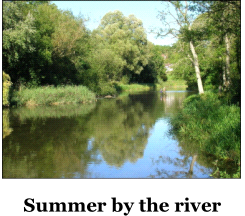 To some anglers the long hot days of summer can present a real challenge when thinking about their trout fishing tactics. The fish which seemed so plentiful only a few weeks ago seem to have packed their bags and gone on vacation! There can be nothing more soul destroying than frying your brain under a relentless sun trying to locate your elusive prey. While there is no doubt that summer can present some challenges, all that is needed is some common sense and a change of strategy.
To some anglers the long hot days of summer can present a real challenge when thinking about their trout fishing tactics. The fish which seemed so plentiful only a few weeks ago seem to have packed their bags and gone on vacation! There can be nothing more soul destroying than frying your brain under a relentless sun trying to locate your elusive prey. While there is no doubt that summer can present some challenges, all that is needed is some common sense and a change of strategy.
Here’s a great video of summer fishing on a river in Pennsylvania.
The first thing to remember is that your fly has to compete with the natural food sources that surround the fish - and this natural food is never more abundant than in the heights of summer. So your fly becomes just one among thousands of potential snacks - it's a wonder we ever catch anything under those conditions. Having said that, we need to find a way to make our fly more attractive and one way is to present it when the rest of the fauna is least active. This time of maximum opportunity will be in the first few hours of the morning, when the chill of the night has slowed everything down and the sun has not yet risen too high in the sky.
 It has been my experience that - in a relatively deep lake - a larva intent on hatching in the evening will start its journey to the surface about mid-morning. These larva live their lives among the bottom debris and weeds, making their perilous journey to the surface to hatch when the call of nature demands it. The majority of these creatures hatch in the evening, so there is a definite period of inactivity in the water during the first few hours of the day. We must take advantage of this opportunity.
It has been my experience that - in a relatively deep lake - a larva intent on hatching in the evening will start its journey to the surface about mid-morning. These larva live their lives among the bottom debris and weeds, making their perilous journey to the surface to hatch when the call of nature demands it. The majority of these creatures hatch in the evening, so there is a definite period of inactivity in the water during the first few hours of the day. We must take advantage of this opportunity.
How, you might ask yourself, do I come to this conclusion - that a larva intent on hatching that evening will begin its ascent to a new world about mid-morning? For ten years I had the opportunity to sit in a boat three or four days a week and study the activity going on under me. This was achieved with the aid of a fish finder. There is absolutely no doubt that the fish start off these summer mornings sitting on or near the bottom. Around mid-morning they can be observed moving slowly up through the water column. The only reason I can conjecture for this activity is that they are following a food source and that can only be a larva which is moving up to hatch later that day.
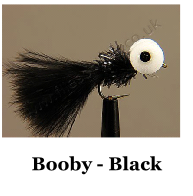 So, we can start these mornings with the use of a booby on a short leader to attack the ten to twelve feet of water where the edges of the weed beds are to be found. The advantage of using a booby here is that the fly is kept near the bottom of the water, where experience tells us that the fish will be. Remember, short sharp jerks are the best form of retrieve and never be afraid to put some speed into it - the fish can swim a darn sight faster than you can retrieve! Sudden stops to allow the booby to rise are absolutely deadly, inducing huge takes.
So, we can start these mornings with the use of a booby on a short leader to attack the ten to twelve feet of water where the edges of the weed beds are to be found. The advantage of using a booby here is that the fly is kept near the bottom of the water, where experience tells us that the fish will be. Remember, short sharp jerks are the best form of retrieve and never be afraid to put some speed into it - the fish can swim a darn sight faster than you can retrieve! Sudden stops to allow the booby to rise are absolutely deadly, inducing huge takes.
There comes a time, however, when the takes start to dry up and the fishing is no more. This occurs when the sun starts to move higher in the sky - that mid-morning period when all good things come to an end - or so it would seem. One would have thought that attempting to follow the fish up through the water column would be our next course of action, but that system does not work - trust me, I tried it often enough! We must look elsewhere for our next inspiration.
You may not have noticed it, but trout do not have eyelids - or sunglasses! The only way they can get away from the unremitting glare of the sun is to find deeper, darker accommodation. So, as one fishing technique stops working we are presented with another opportunity. While trout may have retired from the shallows it does not necessarily follow that they have stopped feeding completely. But, where to find them? And again, my fish finder came to my rescue. They don't just go deep - they go as deep as they can! While everyone else was still thrashing around in the shallows, I quietly slid off to the deep troughs that exist in most large bodies of water. And there they were ... sitting hard on the bottom, perhaps twenty feet or more down.
 Now we must decide how to attack them at that depth. My initial thought was to punch out a hi-d line with my faithful booby on it and that would solve the problem. But it didn't quite work out that way. No matter how much I tried I just couldn't seem to find a booby pattern they were interested in. Back to the drawing board! I surmised that they weren't just sitting down there doing nothing. Trout are eternally hungry, so it would seem to follow that they were at least snacking on something down there. And with the aid of a lot of spooning (a long thin spoon like implement that is used to empty a fish's stomach to see what it has been dining on) I finally worked out what the answer was.
Now we must decide how to attack them at that depth. My initial thought was to punch out a hi-d line with my faithful booby on it and that would solve the problem. But it didn't quite work out that way. No matter how much I tried I just couldn't seem to find a booby pattern they were interested in. Back to the drawing board! I surmised that they weren't just sitting down there doing nothing. Trout are eternally hungry, so it would seem to follow that they were at least snacking on something down there. And with the aid of a lot of spooning (a long thin spoon like implement that is used to empty a fish's stomach to see what it has been dining on) I finally worked out what the answer was.
 In every body of water there exist myriad bugs and insects in different stages of development. Many go through what we generically call a bloodworm stage - that period in their lives when they live on the bottom looking like a little worm. They can develop into many different species of flies and midges and are often overlooked as a food source by the trout fisherman. The problem with using a booby to try and compete with these small worms is exactly that - they are too small to tie up as a booby that could effectively compete and still be buoyant twenty feet down. So, how to solve the problem? Well, if you can't beat them, join them!
In every body of water there exist myriad bugs and insects in different stages of development. Many go through what we generically call a bloodworm stage - that period in their lives when they live on the bottom looking like a little worm. They can develop into many different species of flies and midges and are often overlooked as a food source by the trout fisherman. The problem with using a booby to try and compete with these small worms is exactly that - they are too small to tie up as a booby that could effectively compete and still be buoyant twenty feet down. So, how to solve the problem? Well, if you can't beat them, join them!
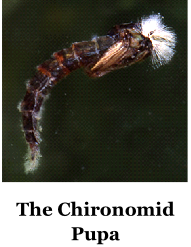 What does a blood worm look like? It looks like a thin, red hook - as simple as that! There is a lovely hook called a grub hook made by Kamasan and a few other quality manufacturers that has an extremely exaggerated bend on the shank. I took this hook - a size eight is ideal - and simply wound two layers of dark red silk onto it, finishing off with an extra set of turns to form a head just below the hook eye. Finally, I spread a little superglue gently over the work of art to hold it all together - and there you have it. One bloodworm ready for action. I always try to make my flies easy to tie - and they don't come simpler than this one. There is more information on tying this fly in the Flies Section. This fly can also be tied as the pupa variant as shown in the picture and here is a video of its construction.
What does a blood worm look like? It looks like a thin, red hook - as simple as that! There is a lovely hook called a grub hook made by Kamasan and a few other quality manufacturers that has an extremely exaggerated bend on the shank. I took this hook - a size eight is ideal - and simply wound two layers of dark red silk onto it, finishing off with an extra set of turns to form a head just below the hook eye. Finally, I spread a little superglue gently over the work of art to hold it all together - and there you have it. One bloodworm ready for action. I always try to make my flies easy to tie - and they don't come simpler than this one. There is more information on tying this fly in the Flies Section. This fly can also be tied as the pupa variant as shown in the picture and here is a video of its construction.
Now, back to the water. My fish finder tells me that I'm sitting over twenty feet of water and the trout are in the bottom three or four feet. How am I going to get my fly down there and fish it in a meaningful way? Remember, this is a small fly moving very slowly, so we can't use a fast sinking line that would be in the zone for only a few moments before hitting the bottom. And an intermediate line would take far too long to get down to depth.
The answer came to me when I realised just how slowly this fly needed to be moved. The only way to slow everything down that much was to use a line that did nothing if I did nothing, and the only line that has that quality is a floating line. So, we are going to use a floating line to fish the bottom of the water. Counter-intuitive, isn't it? This is why you need a pretty good idea of what depth of water you are sitting over.
A fish finder makes finding your depth nice and easy. If you don't own a fish-finder you are missing out on half the story of what is happening under your boat. But don't worry if you haven't equipped yourself with one - you can still use this method of fishing. Instead of simply reading your depth off the machine, you need to drop your anchor gently till it just touches bottom and then haul it back counting to see how many hauls of rope you have retrieved. You need to know in advance how long a haul of rope is for you - but that should not be hard to work out. This will give you the depth of water and thus the length of leader that you are going to put on your floating line. Once you have ascertained your depth slip the anchor back over the side before you drift off the depth and have to start again!
But hold on, I hear you cry ... that's a twenty foot leader. Yes it is and I'm not denying that this could be a handful if you are trying to cast it great distances. But we only need to cast it a small distance because we are going to retrieve it very, very slowly. Using a fluorocarbon leader will also help for several reasons. Firstly, fluorocarbon has a high relative density which makes it heavier than water and will readily sink without the need for any dressings. Secondly, fluorocarbon has little line memory, so once you have straightened it out it will tend to stay straight, rather than coiling up and causing a bird's nest. This involves gently stretching it as you pull it off the spool.
 Sometimes I found it useful to tie a bloodworm pattern with a brass head as the point fly. The brass head is simply a brass bead readily available in tackle outlets. This gives it a little more weight - useful to separate it from the rest of the leader gear when casting and also to aid its speedy descent through the depths. My favourite set-up is to have a brass head bloodworm on the point and one or two droppers without a brass head.
Sometimes I found it useful to tie a bloodworm pattern with a brass head as the point fly. The brass head is simply a brass bead readily available in tackle outlets. This gives it a little more weight - useful to separate it from the rest of the leader gear when casting and also to aid its speedy descent through the depths. My favourite set-up is to have a brass head bloodworm on the point and one or two droppers without a brass head.
How long does it take to sink to depth? This is rather a matter of trial and error - at twenty feet start off leaving it to sink for a minute and increase this time if necessary. The acid test is if the point hook drags slime or mud off the bottom then you know to reduce the waiting time slightly. Another point worth remembering is that all large bodies of water will have a current or undertow. This is caused by the wind pushing the top layer of water in one direction and the underlying layers moving in the opposite direction to compensate. This water movement will cause your extra long leader to bow making exact presentation more difficult. Even so, it won't take long to get the hang of what depth is needed - just look for that tell tale debris in the hook bend.
The floating line, and especially the braided connector attaching the leader to the floating line is likely to sink with the weight of leader and flies and some people are inclined to put a floating sight bob on the front end of the line "to aid in bite detection". This sight bob effectively turns this method into float fishing It’s also known as “fishing the bung”. My personal opinion is that if you are retrieving you should be in contact with your flies and feel any takes, however gentle. It really doesn't matter if the front end of your floating line starts to settle in the water, it's not that critical.
There was a period when big fish were being taken using this method with a long leader fished close to the bottom. No cast was necessary as the rig was simply lowered over the side of the boat. The idea was just to leave the rig out and fish it directly under your rod tip – without any indicator. This was called "Fishing on the Hang". Sooner or later a fish was meant to come along and accept your offering. Forgive me for seeming old fashioned, but if there is no casting and no retrieving, does this qualify as fly fishing? There was even a suggestion that some scoundrels were supergluing real trout pellets to a hook and calling it a fly! Thankfully that technique seems to have died out, although fishing the bung is still an accepted method.
How fast to retrieve? A colleague who uses this technique told me that he retrieves at the rate of "an inch an hour" - but I think he might be exaggerating slightly! The point is that this retrieval rate must be very slow otherwise you will pull the leader up the water column rather than through it. Besides, you are trying to emulate a bloodworm that is not known for its turn of speed when lurking around on the bottom of the lake. And when a take comes it will be positive and hard, the depth tends to give the fish more confidence.
I have also found that one of the most effective ways to retrieve in this method is by twitching the line with a little tug of only an inch or two and then waiting for a few seconds before the next twitch. This is a very natural action for a bloodworm. They tend to jerk up into the water when disturbed, only to fall back again and settle back into the bottom layer. The "twitch and wait" method is perfect to emulate this action.
Once you have a take, play the fish in the normal way. This will mean that you will have the leader coming through the rod rings and into your hand as if it were part of the line. Don't worry about this - just don't try netting the fish with the entire leader still outside of the rod - that doesn't work! I love this fishing technique - there is something satisfying about catching a fish on a long leader when no-one else seems to be able to find them. And it really isn't as hard as you may initially think. Just go try it ...
Many of us have been privileged to witness that wonderful time on a water known as the Evening Rise. All those elusive fish are suddenly splashing around on the surface picking of the emerging fly life as it attempts to leave its watery home and become airborne. The one great frustration I always found was that many lakes and reservoirs have a policy - quite rightly - of closing just before sunset. Exactly the time when the evening rise starts! I hate to think of the number of times I have stood on the jetty watching all the activity and unable to take advantage of it.
Just occasionally the rise will start earlier than normal or you will find yourself on a body of water that permits fishing into the darker hours. If you are that lucky, then a floating line with a dry fly is the order of the day - or night! The biggest problem is trying to keep the fly afloat, they do have a tendency to become waterlogged. The plan is that, after every cast and retrieve, the flies are carefully dried and water repellent is applied to them. There are special floatant applications and drying agents available for this purpose. However, the overall effect is to considerably slow down your fishing activity and I have found this somewhat frustrating at times.
Even dry flies made up with exotic materials such as cul de canard can be difficult to use. Cul de canard is a special feather from around the bottom of a duck (really!) and famed for its quality of staying dry and repelling water. As a last resort I tied up some flies using the same closed cell foam as used in the construction of a booby. By definition, these floated perfectly. Some purists might frown on this as being untraditional - but my flies never, ever got waterlogged and never, ever sank! And they bagged me some great fish! There's more information of fishing the rise in the Bank Fishing Section.
Here’s another thought… When the water temperature starts to rise the fish will go deeper. But they also need to feed. Sometimes they will balance one against the other by feeding in the most comfortable area they can find with the most abundant food source. One day, having tried long leaders with buzzers and bloodworms, nymphs fished deep, back drifting and all the other usual ideas, I finally decided that the fish must have emigrated - or I was doing something wrong! My depth sounder - which does not show fish echoes - had recorded the odd strange smudge right on the bottom. I decided that was worth investigating further, but all my previous attempts would not put a fly that close to the bottom without it disappearing into the mud.
The answer was a small booby on a hi-d line with just a three feet leader and a fast jerky retrieve - four or five two inch tugs and then a pause to give the booby time to float back up slightly or else it would have disappeared into the bottom because of the speed of retrieve. This was in a water depth of fourteen feet - slightly deeper than the usual depth but indicated by the temperature of the water. Having spent fruitless hours on all the other techniques I took twelve fish in just three hours when everyone else had suffered! Perseverance pays - but don’t just keep doing the same thing and hoping for a different outcome….. be versatile!
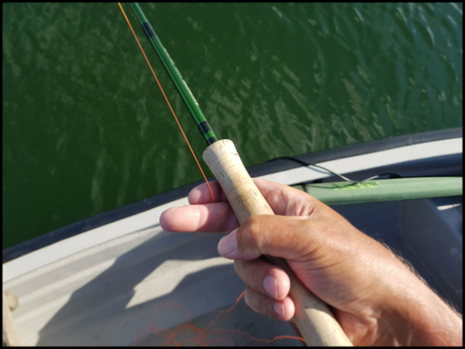 This picture shows how I hold the rod with the line trapped between middle and index finger. The other hand can then be used to give short, sharp downward tugs on the line to imitate a nymph swimming near the bottom of the water. As I use small boobies for this method it is essential to stop and let the fly float back up - I wait up to ten seconds and takes can come at any time. Point the rod directly down the line to make sure the rod does not cushion the tugs and soften their impact on the fly.
This picture shows how I hold the rod with the line trapped between middle and index finger. The other hand can then be used to give short, sharp downward tugs on the line to imitate a nymph swimming near the bottom of the water. As I use small boobies for this method it is essential to stop and let the fly float back up - I wait up to ten seconds and takes can come at any time. Point the rod directly down the line to make sure the rod does not cushion the tugs and soften their impact on the fly.
Finally, here’s a thought about the water conditions you might encounter during the summer: don’t you just hate it when you arrive at your fishing venue only to find the water is full of green stuff – from little specks of green all the way up to globs of green as big as your fist. This stuff is algae, small plant like organisms that thrive in sunlit water, so it’s most likely that your fishing venue will be afflicted with this nuisance during the warmer summer months. You’re not likely to find too many fish in this algal bloom, as it’s called. I would imagine that the fish do not like having to pass this green gloop over their gills when they do the fishy equivalent of breathing!
Where to fish? As far away from the algal bloom as you can find! And that’s upwind. Algae only thrive in sunlight, so that means it will develop in the top few feet of water – the deeper you go the less sunlight and consequently the less plant life, including algae. If you think about it, the wind blows the surface water before it, which is replaced by water from beneath. So the obvious conclusion is that the top layer of water with the algae will be blown downwind – so you have to go upwind to find clearer water. And the fish will come to the same conclusion!
Having said that fish will tend to go upwind in search of cleaner water, inevitably there will be times when there simply is no cleaner water – the green algae has invaded everywhere! So now where are the fish? They have the same problem that we would have if we tried to swim through green pea soup! You can’t see very far and neither can they. My experience is that they will go to the only point of reference they have – the bottom. And they will sit there grubbing around for whatever they can find. So now how are we going to tempt them? The first thing to understand is that whatever you do you have to do it very slowly. Pulling a fly past their nose at speed won’t do it – they simply won’t see it long enough to react.
Having spent several fruitless visits trying to tempt a take in these green-out conditions I noticed that the only anglers getting any sport were the bait fishermen using a worm or some such fished right on the bottom – ledgering or bottom fishing. I believe the fish rely on taste as much as sight in these conditions, so there is no point in putting a fly on the bottom – it won’t register as a food item. The solution I came up with was to use a very slow sinking line and fish it very slowly in the usual places – twelve feet or so of water. I chose a one inch a second sink rate line and after casting it out waited for between thirty and forty-five seconds before starting a slow retrieve. Hey presto – five fish in a couple of hours! The fly of choice was a baby doll or similar fry imitation – the idea is that this little injured fish is swimming slowly past. Another idea to try on those hard fishing days.
Now I’m going to make all this even more confusing! The very next week I visited the same venue I mentioned in the previous paragraph and - needless to say – started off with the same technique as before: a slow retrieve on a very slow sink line (one inch a second) but couldn’t get a touch! This hobby can be so frustrating! The only difference I could see was that now the algae had started clumping together into very short strands rather than just the green, green water I had seen the previous week. Then I spotted another fisherman close by taking a fish on a spinner – and then another. This all set me to thinking. Maybe the fact that the algae had started clumping was allowing more light into the water and that meant the fish didn’t need to sit hard on the bottom. Added to that, I noticed the occasional buzzer in the air; not what you would call a hatch but certainly a few flies were coming off.
A change of plan! The very slow sink line would be too slow to interest a fish that was moving so I changed to a medium sink line – about two inches a second. I still liked the idea of a fry imitation so I put this on the point of a team of three. And I always like to have something orange, so a classic FM hot orange went on the middle dropper - and a Diawl Bach went on the top dropper to imitate a hatching fly. In ten feet of water I started counting to 30 but that caused my point fly (the white zonker I was using as a fry imitation) to catch the bottom and collect weed. Reduce the count to twenty. In five hours, I took twelve fish while those around me took four in total between them as far as I could tell. Eight of my fish had taken the Diawl Bach, one had taken the classic FM orange and three had been tempted by the zonker.
The moral to this tale is to keep your eyes open, analyse what you see and watch what’s going on around you. No two visits are ever the same and only you can work out what you need to do to turn a fruitless day into a success.
Another point worth remembering about algal blooms is that the colouration of the water means that the fish may come into shallower water in brighter conditions – the greening of the water is acting as a sun screen! On several occasions I have found fish splashing around in just six feet of water on a bright sunny day when you would expect them to be away in the deeps. But the green water gives them effective protection. The floating line method with a team of three seemed to fit the bill but I needed to find a fly that would emulate a pin fry but with a gold head to keep it down in the water. The solution I came up with couldn’t be simpler! Using a medium shank size 8 put a few turns of red thread at the eye of the hook and superglue a gold bead in place. Leave it to dry and then simply wind on red thread from the back of the bead down to the bend of the hook, back to the bead and d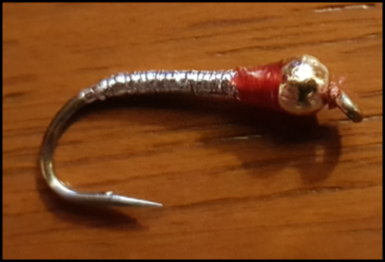 own to the bend again. Catch in some silver or holographic tinsel and wind the thread back up to the bead. Use overlapping turns of the tinsel up to the bead, secure it in place with the thread and snip off the tinsel. Then build up the thread behind the bead before tying off and finishing with a coat of superglue to hold everything in place. This little fly on the point took six fish when no-one else could get a touch!
own to the bend again. Catch in some silver or holographic tinsel and wind the thread back up to the bead. Use overlapping turns of the tinsel up to the bead, secure it in place with the thread and snip off the tinsel. Then build up the thread behind the bead before tying off and finishing with a coat of superglue to hold everything in place. This little fly on the point took six fish when no-one else could get a touch!
BACK TO TOP
TABLE OF CONTENTS
